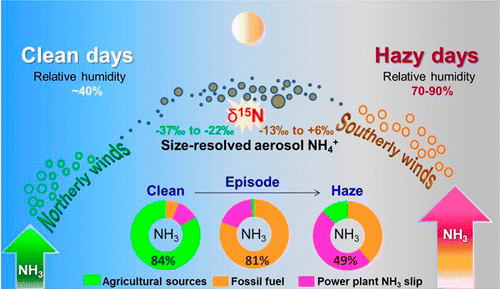Ammonia(NH3) is the only high-concentration alkaline gas in the atmosphere. Ammonia reacts with acid compounds (such as nitric acid and sulfuric acid)to form particulate ammonium (NH4+) or smaller molecular beams, and also plays very important role in aerosol nucleation. Meanwhile, NH3 is also gaseous precursors of heterogeneous phase chemical reaction in the process of secondary inorganic aerosols formation and growth. However, despite the importance of NH3 in urban haze chemistry, this pollutant is currently not included in emission control policies in China and/or in other regions worldwide that also experience severe haze pollution. Besides, a debate continues over whether agricultural missions dominate atmospheric NH3in urban areas.
Recently, Prof.Yunting Fang and his group at IAE cooperated with Dr.Yuepeng Pan at Institute of Atmospheric Physics, CAS, Prof. Qiang Zhang at Tinghua University, and Prof. Greg Michalski at Purdue University, and was trying to identify NH3emission sources and quantify the relative contributions of different sources to theNH3budgets.Based on the chemical and isotopic measurements of size-resolved aerosols in urban Beijing, 2013, the research showed that the 15N natural abundance (δ15N) of NH4+ in fine particles varies with the development of haze episodes, ranging from −37.1‰to−21.7‰during clean/dusty days (relative humidity:∼40%), and−13.1‰ to +5.8‰ during hazy days (relative humidity: 70−90%). The research indicated that fossil fuel-based emissions contribute 90% of NH3during haze days in urban Beijing. This research highlight the contribution of fossil fuel combustion to NH3emission during the haze days in urban areas.
This work was supported by NNSFC and CAS Strategic Priority Research Program. The work has published in a top journal Environmental Science & Technology (ES&T,2015 Impact Factor: 5.393), and entitled as ‘Fossil fuel combustion-related emissions dominate atmospheric ammonia sources during severe haze episodes: Evidence from 15N-stable isotope in size-resolved aerosol ammonium’.

Full text URL: http://pubs.acs.org/doi/abs/10.1021/acs.est.6b00634b
Abstract: The reduction of ammonia (NH3) emissions is urgently needed due to its role in aerosol nucleation and growth causing haze formation during its conversion into ammonium (NH4+). However, the relative contributions of individual NH3 sources are unclear, and debate remains over whether agricultural emissions dominate atmospheric NH3 in urban areas. Based on the chemical and isotopic measurements of size-resolved aerosols in urban Beijing, China, we find that the natural abundance of 15N (expressed using δ15N values) of NH4+ in fine particles varies with the development of haze episodes, ranging from -37.1‰ to -21.7‰ during clean/dusty days (relative humidity: ~40%), to -13.1‰ to +5.8‰ during hazy days (relative humidity: 70-90%). After accounting for the isotope exchange between NH3 gas and aerosol NH4+, the δ15N value of the initial NH3 during hazy days is found to be -14.5‰ to -1.6‰, which indicates fossil fuel-based emissions. These emissions contribute 90% of the total NH3 during hazy days in urban Beijing. This work demonstrates the analysis of δ15N values of aerosol NH4+ to be a promising new tool for partitioning atmospheric NH3 sources, providing policy makers with insights into NH3 emissions and secondary aerosols for regulation in urban environments.
Publication Name: Yuepeng Pan, Shili Tian, Dongwei Liu, Yunting Fang, Xiaying Zhu, Qiang Zhang, Bo Zheng, Greg Michalski, and Yuesi Wang.
E-mail: fangyt@iae.ac.cn.